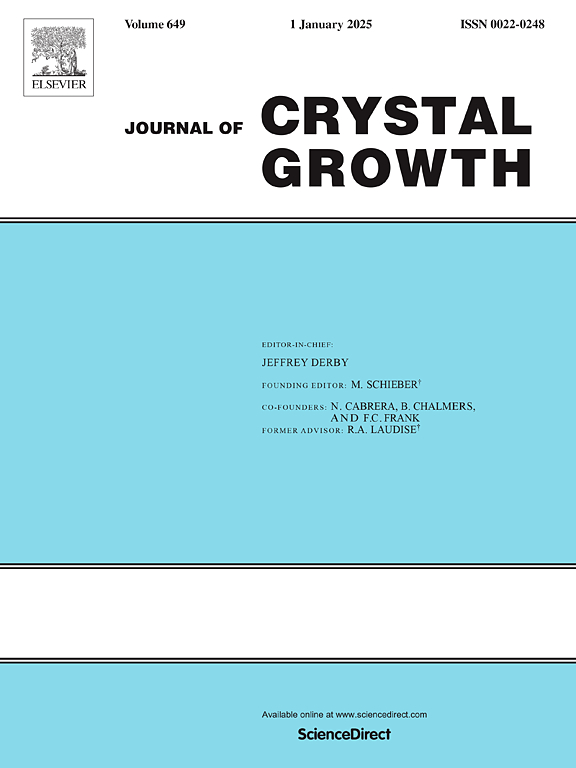Cu2-xS纳米晶的相位可调合成及其阳离子取代反应
IF 2
4区 材料科学
Q3 CRYSTALLOGRAPHY
引用次数: 0
摘要
利用Cu2-xS纳米晶体(NCs)的阳离子取代(CS)反应已成为制备复杂纳米结构和亚稳相的一种强有力的合成方法。对于这些CS反应,调整Cu2-xS NCs的晶相非常重要,因为它对反应动力学、热力学、反应中间体和最终产物都有很大的影响。本文通过简单调整硫脲(TU)的用量,合成了六方相双闪闪岩Cu1.94S NCs和立方相辉长岩Cu1.8S NCs。其中,0.5 mmol的TU对闪闪岩Cu1.94S NCs的形成起作用,5.0 mmol的TU对辉长岩Cu1.8S NCs的形成起作用。然后用Zn2+和Cd2+取代cu1.94 4s和辉长岩Cu1.8S NCs,制得六方相武锌矿ZnS和CdS NCs,立方相锌闪锌矿ZnS和CdS NCs。如果没有CS方法,这些ZnS和CdS nc很难访问。因此,我们在本研究中的发现为Cu2-xS纳米结构提供了一种直接的相位调整方法,并为创建更复杂的金属硫化物纳米(异质)结构提供了潜在的指导。本文章由计算机程序翻译,如有差异,请以英文原文为准。

Phase tunable synthesis of Cu2–xS nanocrystals and their cation substitution reactions
Cation substitution (CS) reactions utilization of Cu2–xS nanocrystals (NCs) have been emerged as a powerful postsynthetic method to produce complicated nanostructures and metastable phases. For these CS reactions, it is of great importance to tune the crystal phase of the Cu2–xS NCs since it strongly affects the reaction kinetics, thermodynamics, reaction intermediates, and final products. Herein, hexagonal phase djurleite Cu1.94S NCs and cubic phase digenite Cu1.8S NCs were synthesized by simple tuning of the amount of thiourea (TU). In particular, 0.5 mmol of TU is responsible for the formation of the djurleite Cu1.94S NCs, while 5.0 mmol of TU is responsible for the formation of the digenite Cu1.8S NCs. Afterward, the Cu1.94S and digenite Cu1.8S NCs were substituted by Zn2+ and Cd2+, and hexagonal phase wurtzite ZnS and CdS NCs, cubic phase zincblende ZnS and CdS NCs were produced. These ZnS and CdS NCs are otherwise difficult to access without the CS method. Therefore, our findings in the present study provide a straightforward phase tuning of the Cu2–xS NCs, and potential guidelines for creating more complicated metal sulfide nano(hetero)structures.
求助全文
通过发布文献求助,成功后即可免费获取论文全文。
去求助
来源期刊

Journal of Crystal Growth
化学-晶体学
CiteScore
3.60
自引率
11.10%
发文量
373
审稿时长
65 days
期刊介绍:
The journal offers a common reference and publication source for workers engaged in research on the experimental and theoretical aspects of crystal growth and its applications, e.g. in devices. Experimental and theoretical contributions are published in the following fields: theory of nucleation and growth, molecular kinetics and transport phenomena, crystallization in viscous media such as polymers and glasses; crystal growth of metals, minerals, semiconductors, superconductors, magnetics, inorganic, organic and biological substances in bulk or as thin films; molecular beam epitaxy, chemical vapor deposition, growth of III-V and II-VI and other semiconductors; characterization of single crystals by physical and chemical methods; apparatus, instrumentation and techniques for crystal growth, and purification methods; multilayer heterostructures and their characterisation with an emphasis on crystal growth and epitaxial aspects of electronic materials. A special feature of the journal is the periodic inclusion of proceedings of symposia and conferences on relevant aspects of crystal growth.
 求助内容:
求助内容: 应助结果提醒方式:
应助结果提醒方式:


